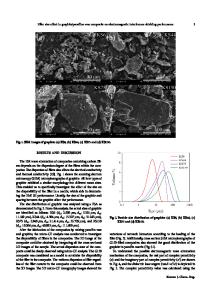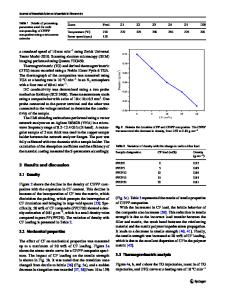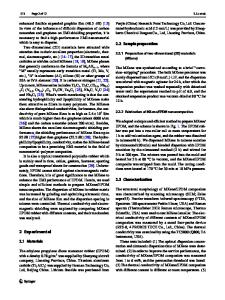Flexible and conductive PP/EPDM/Ni coated glass fiber composite for efficient electromagnetic interference shielding
- PDF / 2,396,239 Bytes
- 8 Pages / 595.276 x 790.866 pts Page_size
- 70 Downloads / 343 Views
Flexible and conductive PP/EPDM/Ni coated glass fiber composite for efficient electromagnetic interference shielding Hongji Duan1,2 · Mingjuan Zhao1 · Yaqi Yang1 · Guizhe Zhao1 · Yaqing Liu1 Received: 6 January 2018 / Accepted: 10 April 2018 © Springer Science+Business Media, LLC, part of Springer Nature 2018
Abstract Efficient electromagnetic interference (EMI) shielding performance for sealing materials exposed to the environment has become an increasing requirement in the precision electronics, aerospace and military applications. Nowadays, it is still a big challenge to prepare EMI shielding seal material with recyclable and low cost characters. Herein, the flexible polypropylene/ethylene-propylene-diene monomer/nickel coated glass fiber (PP/EPDM/NCGF) shielding composite is fabricated via electroless deposition and melt-reactive blending method. The Ni layer coated on the surface of glass fiber constructs a 3D conductive network in the composite ascribed to the well-connected glass fiber skeleton. The composite exhibits an EMI SE of 22.2 dB and elongation at break of 126.5% by adding only 1 vol% Ni (16.36 vol% NCGF). The good mechanical property and satisfied EMI shielding effectiveness suggest that TPV/NCGF is a promising substitution to fabricate recyclable, lightweight and low cost shielding seal materials.
1 Introduction The rapid development of highly integrated electronic devices and the necessity to design precise signal transmission devices have led to the emergence of electromagnetic interference (EMI) [1]. EMI does not only cause signal distortion, leading to malfunctions of electronic, but also causes harmful effects on human health [2–5]. Therefore, developing EMI shielding materials that meet various demands of using is necessary. Sealing materials exposed to the environment in precision electronics, aerospace and military applications always require EMI shielding performance nowadays, which is still a big challenge. The traditional strategy for the preparation of shielding seal material is adding highly conductive metal * Yaqi Yang [email protected] * Yaqing Liu [email protected] 1
Key Laboratory of Functional Nanocomposites of Shanxi Province, College of Materials Science and Engineering, North University of China, Taiyuan 030051, People’s Republic of China
State Key Laboratory of Polymer Materials Engineering, Sichuan University, Chengdu 610065, People’s Republic of China
2
powders (silver powders, copper powders, nickel powders) into a rubber matrix [6, 7]. However, the irreversible vulcanized structure and the incorporation of various additions make the recycling of the conducive rubber a serious technical, economic and ecological problem [8]. In addition, high metal filler loadings (> 70%) are always required to achieve the EMI shielding effect, which inevitably result in high density, high cost and low processability [9]. The large amount metal powder is also hardly recycled. Therefore, it has significant meaning to replace traditional EMI shielding rubber with a recyclable, l
Data Loading...











